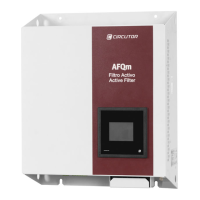43
Instruction Manual
AFQm
Figure 36:Approximate graph for calculating the FS
h
.
4.4.- RESONANCE DETECTION
The AFQm acts as a current, frequency and variable amplitude generator. This current circulates via the
path of least impedance, which should be the mains.
In certain cases, there may be a load that provides less impedance than the mains, in which case a res-
onance phenomenon will be produced with that load. The AFQm has a detection system for resonance
with loads, which automatically deactivates the harmonic that causes that resonance.
In environments with a high level of short-circuit impedance of the mains and a high level of voltage
THD, a condition may occur that the filter erroneously detects as resonance.
In such conditions, the filter action improves the current THD, which causes an improvement of the
voltage THD. The improvement of the voltage THD causes the loads to increase their consumption,
producing a deterioration of the current THD. The user will see that the current THD is worse when
connecting the filter, or that the filter does not correct the current THD as expected. In addition, the
filter detects an increase in the current when correcting the current THD, which it understands as a
resonance, thus activating the protection elements.
If the installation behaves in this way, contact the TAS (Technical Assistance Service) to carry out the
necessary checks to deactivate the resonance alarm safely.
4.5.- SELF-DIAGNOSIS
The device is fitted with a self-diagnosis system. The device checks the integrity of the hardware and
software control elements when starting up. This analysis is carried out according to IEC60730.
This system ensures the device remains in a safe state in the event of failure. The user is alerted to the
failure thanks to an on-screen message and it is also found in the Modbus register.
This type of failure indicates damage or degradation of any of the control and process elements, both
hardware and software. Turning off the device and contacting TAS is recommended whenever this
alarm comes about.

